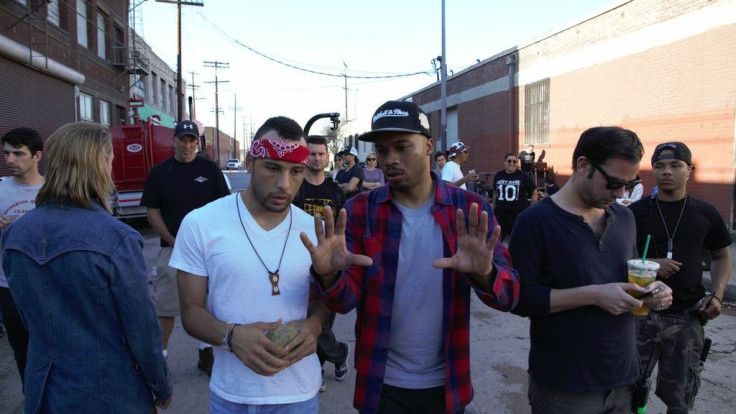‘The Man’ Music Video Director Matty Barnes Talks Aloe Blacc And Goes Behind-The-Scenes [EXCLUSIVE]

“The Man,” by artist Aloe Blacc has quickly become an aspirational song for people all over the globe. With lyrics such as “Somewhere I heard that life is a test I been though the worst but still I give my best,” the R&B hit has become an anthem, even being used in two prominent Beats by Dre commercials featuring San Francisco 49ers quarterback Colin Kaepernick and Brooklyn Nets center Kevin Garnett.
The music video, which was released in March, already has drawn nearly 8 million views since it's March debut, and powerfully touches on race, discrimination, and unity, while taking us back to the civil rights era and other momentous moments in American history. The director behind the inspiring video, St. Louis native Matty Barnes, 30, spoke with International Business Times about his career, how the collaboration with Blacc came about, the concept for “The Man” and more.
IBT: How did you know that directing music videos was your calling?
Barnes: I started in high school. I was an aspiring basketball player and video technology student and needed a way to let coaches and others know I existed. I started taking footage and putting together highlight reels, mini short films and music videos, and it was compelling and interesting to me. At that point teachers said I should consider film school. So I gave up basketball and got involved in film. And my videos were always music based. Music a lot of times fuels sports, and it’s the perfect soundtrack to go with performance. A lot of my work is based on performance and it’s a very important thing to me so I thought why not marry the two things that fuel each other?
IBT: How did you end up teaming up with Aloe Blacc?
Barnes: It’s a weird story. I work with a creative team that created the Beats by Dre commercials featuring Kaepernick and Garnett so that’s how the process started. It happened so naturally because the commercials were about “how do we create a video that has the same power and drama as the commercials?” So if you deconstruct the Dr. Dre commercials and what they represent: black kids in the '60s riding buses during desegregation -- it’s a metaphor and we just put athletes in place of children.
IBT: What was Aloe’s goal with the concept for “The Man” and how did you make his vision come to life?
Barnes: Aloe said, “I want to do something strong and powerful and cool.” And fortunately, I have a great team of creative people who develop ideas with me.
So we decided to take the Beats by Dre commercials further (Dr. Dre’s commercials featuring “The Man” were released several months before Aloe’s video was made), and be more literal for Aloe’s video. We spoke with Aloe and his manager and I asked him a series of questions -- what’s your inspiration, what do you like, etc., and he said old album covers like Marvin Gaye’s “What’s Going On.” He also mentioned the 1970s sitcom “Good Times,” which revolved around a poor African-American family, and Ernie Barnes’ landmark work, “Sugar Shack.” So we were on to something and I broke it down.
I said, let’s do an homage to classic album covers from '60s and '70s because he [Aloe] is a soul singer. Take the classic Gaye album cover “What’s Going On?” and what was going on at that time? Protests, discrimination, etc., so with “I’m The Man” video we were depicting this Marvin Gaye moment, but we pull back and show protests and riots. We tried to represent and depict classic moments in time which we liked and slowly revealed more information as camera pulled back, providing commentary on what was going on during those times. I just wanted to add different layers to each scene. How can I make this more dramatic? I did my research on what was going on during that time and kicked off from there.
IBT: Were you worried about people not grasping the meaning of the video?
Barnes: We didn’t want to just do a snapshot; we wanted to add layers, so the video’s much deeper. I was like “how do I communicate that? We love this idea but how do we communicate this to like 14-year-olds who are unaware?” I had to say this is an experience that requires smart and patient viewing. We want to reset audience’s expectations of videos, bring it back to classic r’n’b. We want people to watch the video multiple times to understand it because it has numerous layers. We show strong moments. And if you don’t get Aloe’s message that’s fine, because just his presence is enough.
IBT: How long did it take to make “The Man?”
Barnes: We had less than a week to prep video, though we had the idea for two or three weeks. We had another week to edit it. Originally we wanted an interactive experience, which is the future of music, in which viewers and artists can connect. But we didn’t have enough time. So Aloe instead wrote in the comments section on the video’s site, and asked people questions about scenes from the video and who he’s paying homage to.
IBT: Who do you ultimately want to work with?
Barnes: Anyone who is willing to be bold and creative. Michael Jackson would’ve been the ultimate, but anyone willing to push envelope. I respect that about Aloe’s team -- they took a risk.
© Copyright IBTimes 2024. All rights reserved.






















